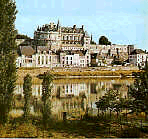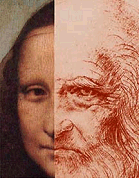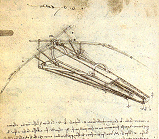Leonardo Da Vinci
Leonardo was born in the small town of Vinci, in Tuscany, near Florence on April 15, 1452. He was the illegitimate son of a wealthy Florentine notary and a young peasant woman named Caterina. In the mid 1460s they settled in Florence, where Leonardo was given the best education that Florence could offer. He advanced socially and intellectually. He was handsome, persuasive, and a fine musician.
In about 1466 he was apprenticed as a studio boy to Andrea del Verrocchio, the leading Florentine painter and sculptor at that time. In Verrocchio's workshop Leonardo was introduced to many activities like painting altarpieces and panel pictures and creating large projects in marble and bronze. In 1472 he was entered in the painter's guild of Florence. In Verrocchio's painting, Baptism of Christ, the kneeling angel at the left of the painting was done by Leonardo.
In 1478 he became independent. His first commission was to paint an altarpiece for the chapel of the Florentine town hall, but it was never executed. His first large painting, The Adoration of the Magi, begun in 1481, but he left it unfinished. Other works ascribed to his youth are the so-called Benois Madonna, created around 1478, the portrait Ginevra de' Benci, created around1474, and the unfinished Saint Jerome, created in 1481.
In about 1482, Leonardo entered the service of the duke of Milan, Ludovico Sforza. He wrote the duke a letter, in which he stated that he could build portable bridges, construct bombardments and make cannons, build ships as well as armored vehicles, catapults, and other war machines, and that he could execute sculpture in marble, bronze, and clay. The duke was very impressed by the letter and accepted him. He served as principal engineer in the duke's military enterprises and was active also as an architect. In addition, he assisted the Italian mathematician Luca Pacioli in the celebrated work Divina Proportione in 1509.
Evidence indicates that Leonardo had apprentices and pupils in Milan. He probably wrote the various texts later compiled as Treatise on Painting for them. The most important of his own paintings during the early Milan period, was The Virgin of the Rocks. Two versions of it exist today. One version can be found in Louvre, Paris, and the other can be found in the National Gallery, London. He worked on the compositions for a long time, which was his custom, and made it seem that he was unwilling to finish what he had begun. From 1495 to 1497, Leonardo worked on his masterpiece, The Last Supper, which was a mural in the refectory of the Monastery of Santa Maria delle Grazie, Milan. Unfortunately, his experimental use of oil on dry plaster was technically unsound, and by 1500 it had already begun deteriorating. Since 1726, attempts have been made, unsuccessfully, to restore it. A concerted restoration and conservation program, making use of the latest technology, begun in 1977 and is reversing some of the damage. Though much of the original surface is gone, the composition and the characterization of the figures still give a slight vision of its vanished brilliance. Around that same time, he took up scientific fields as diverse as anatomy, biology, mathematics, and physics.
During his long stay in Milan, Leonardo also produced other paintings and drawings (most of which got lost ), theater designs, architectural drawings, and models for the dome of Milan Cathedral. His largest commission was an enormous bronze monument for Francesco Sforza. In December 1499, however, the Sforza family was driven from Milan by French forces. Leonardo left the statue unfinished and returned to Florence in 1500. The statue was later destroyed by French archers.
In 1502 Leonardo entered the service of Cesare Borgia. As the duke's chief architect and engineer, Leonardo supervised work on the fortresses of the papal territories in central Italy. In 1503 he was a member of a commission of artists who were to decide on the right location for David, the famous colossal marble statue by the Italian sculptor Michelangelo, created from 1501-1504. He also served as an engineer in the war against Pisa. Toward the end of the year Leonardo began to design a decoration for the hall of the Palazzo Vecchio. The subject was the Battle of Anghiari, a Florentine victory in its war with Pisa. He made several drawings for the decoration and completed a full-size sketch, in 1505, but he never finished the wall painting. The cartoon itself was destroyed in the 17th century, and the composition survives only in copies. The most famous of which is by the Flemish painter Peter Paul Rubens and is located in Louvre.
During this second Florentine period, Leonardo painted several portraits, but the only one that survives is the famous Mona Lisa, which was painted from 1503-1506. One of the most celebrated portraits ever painted, it is also known as La Gioconda, after the presumed name of the woman's husband. Leonardo seemed to have had a special affection for the picture, for he took it with him on all of his travels.
In 1506 Leonardo went back to Milan, summoned by its French governor, Charles d'Amboise. The following year he was named court painter to King Louis XII of France, who was then residing in Milan. For the next six years Leonardo divided his time between Milan and Florence, where he often visited his half brothers and half sisters and looked after his inheritance. In Milan he continued his engineering projects and worked on a figure for a monument to Gian Giacomo Trivulzio. Although the project was not completed, drawings and studies have been preserved. In 1516 he traveled to France to enter the service of King Francis I. He spent his last years at the Château de Cloux, near Amboise, where he died May 2, 1519.

Although Leonardo produced a relatively small number of paintings, many of which remained unfinished, he was nevertheless an extraordinary and influential artist. During his early years, his style was very similar to that of Verrocchio, but he gradually moved away from his teacher's stiff treatment of figures to develop a more atmospheric style of composition. The early painting The Adoration of the Magi introduced a new approach to composition, in which the main figures are grouped in the foreground, while the background consists of distant views of imaginary ruins and battle scenes.
Leonardo's style became even more apparent in The Last Supper, in which he represented a traditional theme in an entirely new way. Instead of showing the 12 apostles as individual figures, he grouped them in dynamic units of three, framing the figure of Christ, who is isolated in the center of the picture. Seated before a pale distant landscape seen through a rectangular opening in the wall, Christ, who is about to announce that one of those present will betray him, appears to be quite calm and still, while the others respond with animated gestures. Leonardo was also among the first to introduce atmospheric perspective into his landscape backgrounds.

The Mona Lisa, Leonardo's most famous work, is well known for the mysteriousness of its legendary smiling subject. This work is a consummate example of two techniques – sfumato and chiaroscuro – of which Leonardo was one of the first great masters. Sfumato is characterized by subtle transitions between color areas, creating a delicately atmospheric haze or smoky effect. It is especially evident in the delicate gauzy robes worn by the sitter and in her enigmatic smile. Chiaroscuro is the technique of modeling and defining forms through contrasts of light and shadow. The sensitive hands of the sitter are portrayed with an emphasis of light and shade, while color contrast is used only sparingly. There is also a great mystery as to who the painting was modeled after. I watched an episode of unsolved mysteries a while ago that suggested the painting was modeled after Leonardo himself. Dr. Lillian Schwartz, of Bell Labs, compared the shape of the face and the wrinkles in the forhead of the woman to those of Leonardo and they matched up almost perfectly. The nose was also the same shape and length as that of Leonardo, and his self portrait, compared to the Mona Lisa also showed a great deal of similarity when focussing on the chin and jawbone of the two. No one knows for sure, however, who the painting was really modeled after.

As a scientist, Leonardo’s theories, like his artistic views, were based on careful observation and precise documentation. He understood better than anyone the importance of precise scientific observation. Unfortunately, just as he frequently failed to bring artistic projects to conclusion, he never completed his projects on a variety of scientific subjects. His theories are contained in numerous notebooks, most of which were written in mirror script in order to keep his servants from betraying his opinions and observations to the police. He was left-handed and he wrote all of his theories from right to left so that no one but he could understand them. Because they were not easily comprehensible, Leonardo's findings were not considered in his own lifetime. Had they been published, they would have revolutionized the science of the 16th century. Leonardo actually anticipated many discoveries of modern times. In anatomy he studied the circulation of the blood and the action of the eye. He made discoveries in meteorology and geology, learned the effect of the moon on the tides, foreshadowed modern conceptions of continent formation, and came close to discovering the nature of fossil shells. He was among the originators of the science of hydraulics, and his scheme for the canalization of rivers is still in use. He invented a large number of ingenious machines, among them an underwater diving suit. His flying devices, although not practicable, embodied sound principles of aerodynamics.

Leonardo Da Vinci was a Florentine artist, one of the great masters of the High Renaissance, celebrated as a painter, sculptor, architect, engineer, and scientist. His love of knowledge and research was the cause of both his artistic and scientific studies. His creations in the field of painting influenced the course of Italian art for more than a century after his death, and his scientific studies in the fields of anatomy, optics, and hydraulics anticipated many of the recent developments of science that are still being used today.